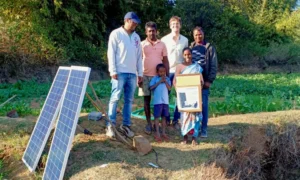Badarkhali (Barguna), Bangladesh
The sufferings of Abdur Rahim Molla know no end. In May and June earlier this year, his coastal village Padma in Barguna district faced floods leading to displacement of people. That was followed by deficient rainfall in the monsoon season because of which farmers faced great difficulty in cultivating paddy.
And now, after toiling in the fields for weeks at a stretch, when the paddy was ready to harvest, Cyclone Sitrang, which hit the Bangladesh coast on the night of October 24, has flattened their standing crops.
“I had hoped to harvest enough paddy to keep my family fed for five months at least. But Cyclone Sitrang has left me with nothing,” Abdur Rahim told Gaon Connection. It was a replay of what had happened in 2007 when Cyclone Sidr had wreaked havoc in his village and had damaged his entire crop of ripe paddy, the coastal farmer recalled.
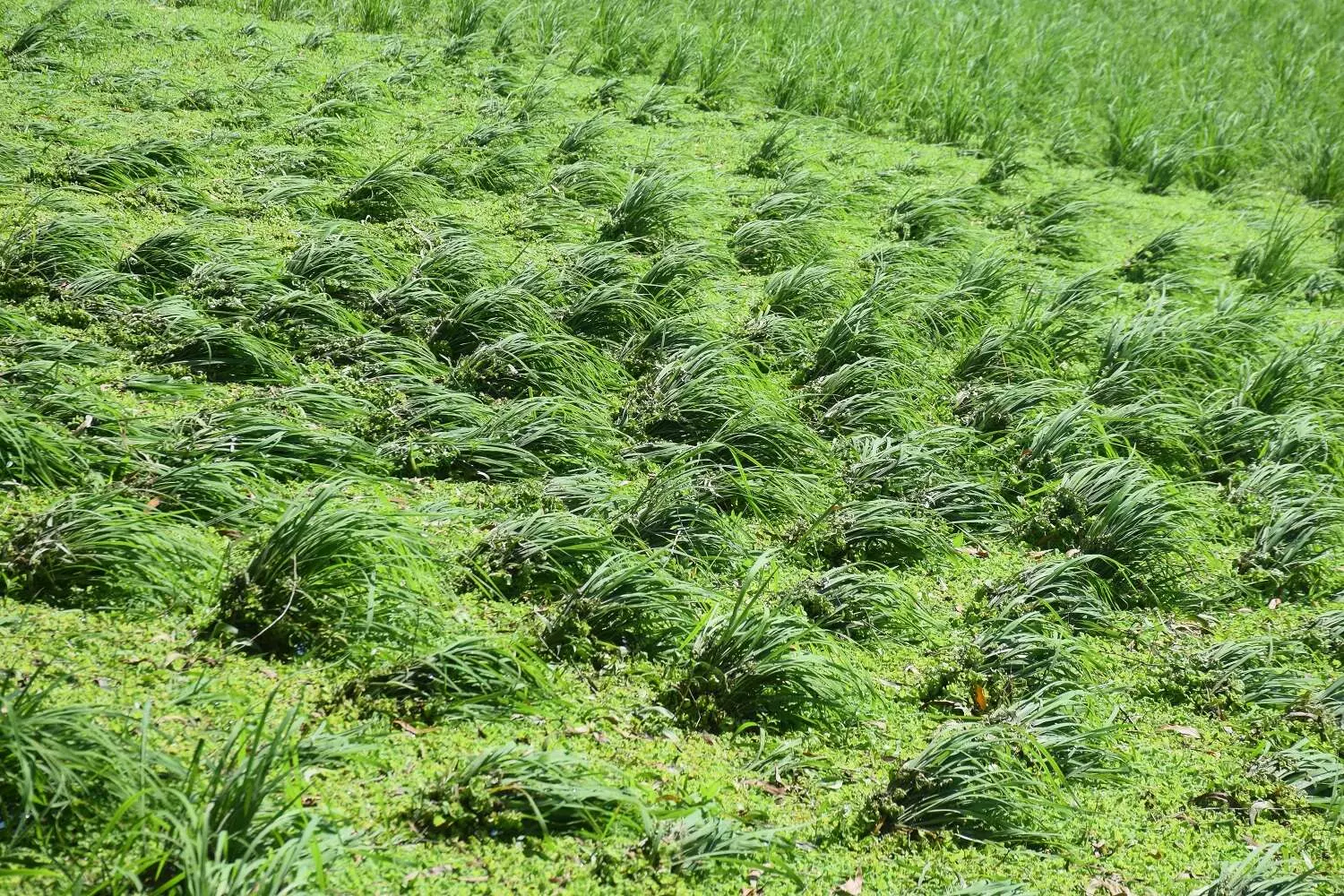
This paddy field of Badarkhali village of Barguna Sadar Upazila is submerged in water due to Sitrang.
Sitrang made a landfall in southern Bangladesh late in the night of Diwali festival. As per news reports, at least 35 people have been reportedly killed due to the cyclone and millions are affected in the delta country. A day after the cyclone made the landfall, over 10 million people were without power in districts along the coast. Large scale destruction of the Aman paddy crop has been reported, too.
Incidentally, the cyclone has hit Bangladesh just 12 days before the commencement of the 2022 United Nations Climate Change Conference, commonly referred to as COP27, which is being held next month from November 6 to November 18 in Egypt.
Climate scientists have documented how global warming and rising sea temperatures are leading to an increase in both the frequency and intensity of tropical cyclones. And farmers like Abdur Rahim are facing the maximum brunt.
Also Read: COP26: Climate justice is the strident war cry of young activists in Bangladesh
“There was a lot of delay in paddy cultivation this year due to lack of water. There was no rain and I had to pay to irrigate my paddy fields,” Abdul Rahim said. The paddy was coming along nicely and he was hoping his expenses would be worth it this year, but Cyclone Sitrang put an end to that.
“We are once again staring at loss,” Idris Howladar, a farmer from Madhyam Gazi Mahmud village in Barguna Sadar Upazila, told Gaon Connection. “We began with a drought and ended with a cyclone that destroyed our paddy,” he said.

Idris Howladar, a farmer of Madhyam Gazi Mahmud village of Barguna Sadar Upazila, has suffered heavy damage to his crops due to Cyclone Sitrang.
Ideally, this is the time when water levels in the field should be no more than six inches (0.5 foot), Howaldar pointed out. “But our fields are under two-and-a-half to three feet of water. The rice will rot,” he said dejectedly.
October and November is when the paddy fields are ripe for harvest in Bangladesh. But, this time many farmers like Abdul Rahim and Howaldar are staring at huge losses and hunger in the face as their paddy fields are drowned in water. Hawladar informed that he had spent Bangladeshi taka (Tk) 30,000 this year to cultivate his land, and an additional Tk 10,000 to irrigate it due deficient rainfall in the monsoon months.
In a recent press conference, Enamur Rahman, state minister for disaster and relief said that it would take another two weeks to prepare the estimate of the full extent of damage caused by Cyclone Sitrang. According to him, initial estimates established that 419 unions in Bangladesh were hit with about 10,000 houses being damaged. Official figures put the death toll at nine, but non-government figures put the death toll at a much higher 35.
Also Read: Bangladesh: Floods have come and gone, leaving behind destruction and ‘climate refugees’
Floods, drought, and a cyclone
Bangladesh was hit by floods in May and June earlier this year and the lives of more than seven million people in the northeastern region was severely disrupted. This was followed by severe drought that disrupted Aman cultivation.
Data from the Bangladesh Agricultural Extension Department revealed that Aman paddy was cultivated in 5.657 million hectares of land across the country this year. Of this, about 1.1 million hectares were in the three coastal divisions in Chittagong, Khulna and Barisal.
Aman paddy is a rainfed crop of Bangladesh. This is 39 per cent of the total grain produced in the delta country. Aman production depends largely on monsoon rains. June to August is the end of the seed bed preparation period for planting seedlings. This period is considered as the peak monsoon season.
But, a drought followed by unprecedented rains and floods have thrown the entire planting cycle into disarray this year.
Also Read: Cyclone Amphan’s anniversary of despair
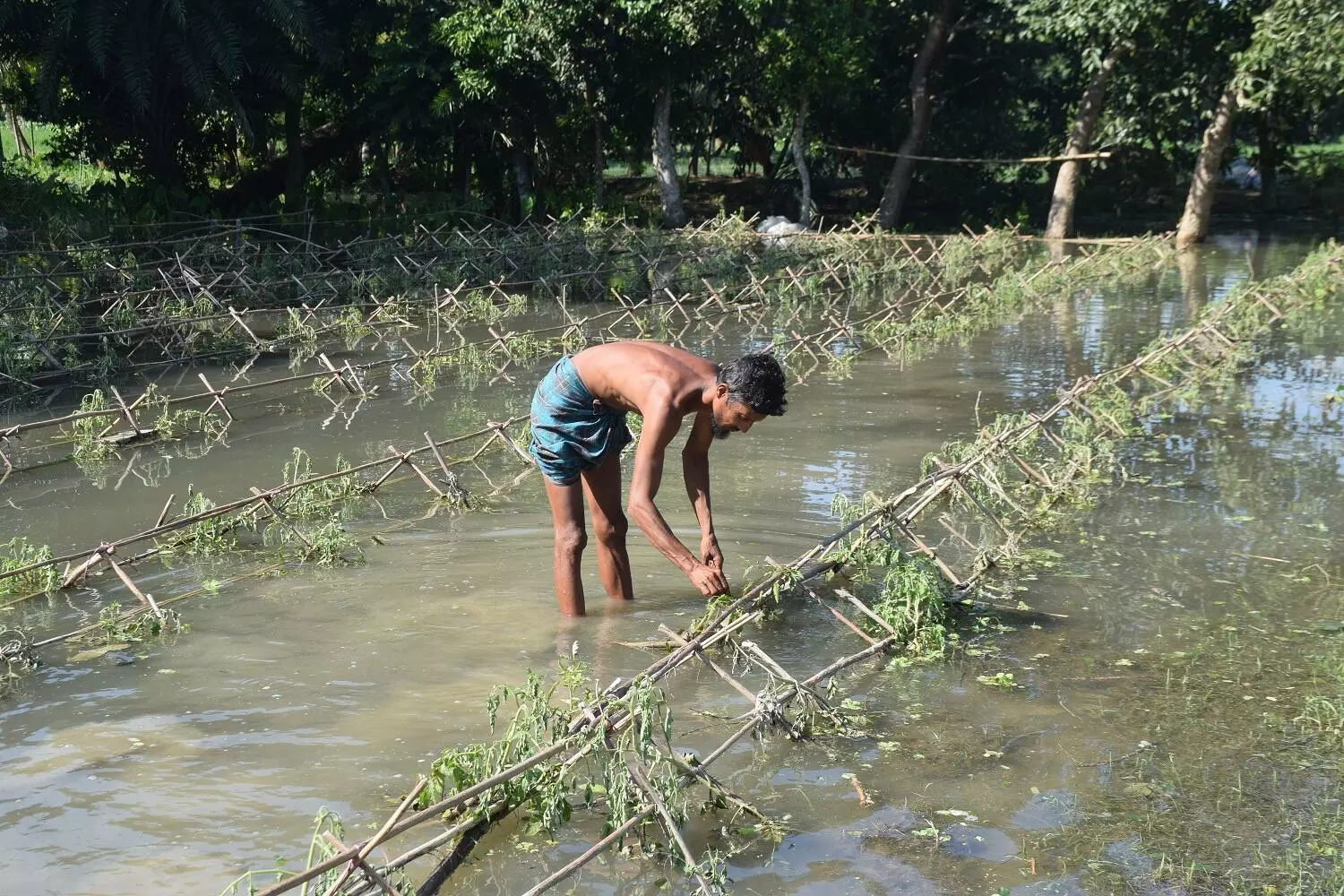
Mohammad Shaheen, a resident of Majherchar, cultivated winter crops in his field. His crop fields are now submerged in water.
Increasing vulnerabilities
People living on the coast of Bangladesh are the most vulnerable. Sirajul Islam, a resident of the isolated island of Dhalchar in Charfasan upazila (sub-district) of Bhola district, watched as all his belongings were washed away by Cyclone Sitrang. Only the shed of the house is still standing. Along with his family, Sirajul Islam has taken shelter at a relative’s home.
Noorannabi Majhi who lived close to where Islam lived also lost his house to the floods. He had to flee the area with his family of six and seek shelter elsewhere.
“The people of this island are always at risk. The risk of natural hazards is greater now than ever before. All the houses on the island were submerged by high tide during Cyclone Sitrang,” Sharif Saudagar, another resident of Dhalchar Island, told Gaon Connection.
Around 300 mud houses have been destroyed on Patenga coast of Chittagong during Cyclone Sitrang. Many people are living outdoors in the South Halishahar, North Patenga and South Patenga areas of Chittagong city as their homes are destroyed.
“The cyclone hit at 10.30 pm, and I took refuge on the embankment with my three children. I thought I would return home after the cyclone passed, but there was nothing to return to,” Champa Rani Jaldash of Chittagong, told Gaon Connection. “My husband’s fishing net that cost lakhs of taka was washed away,” she added.
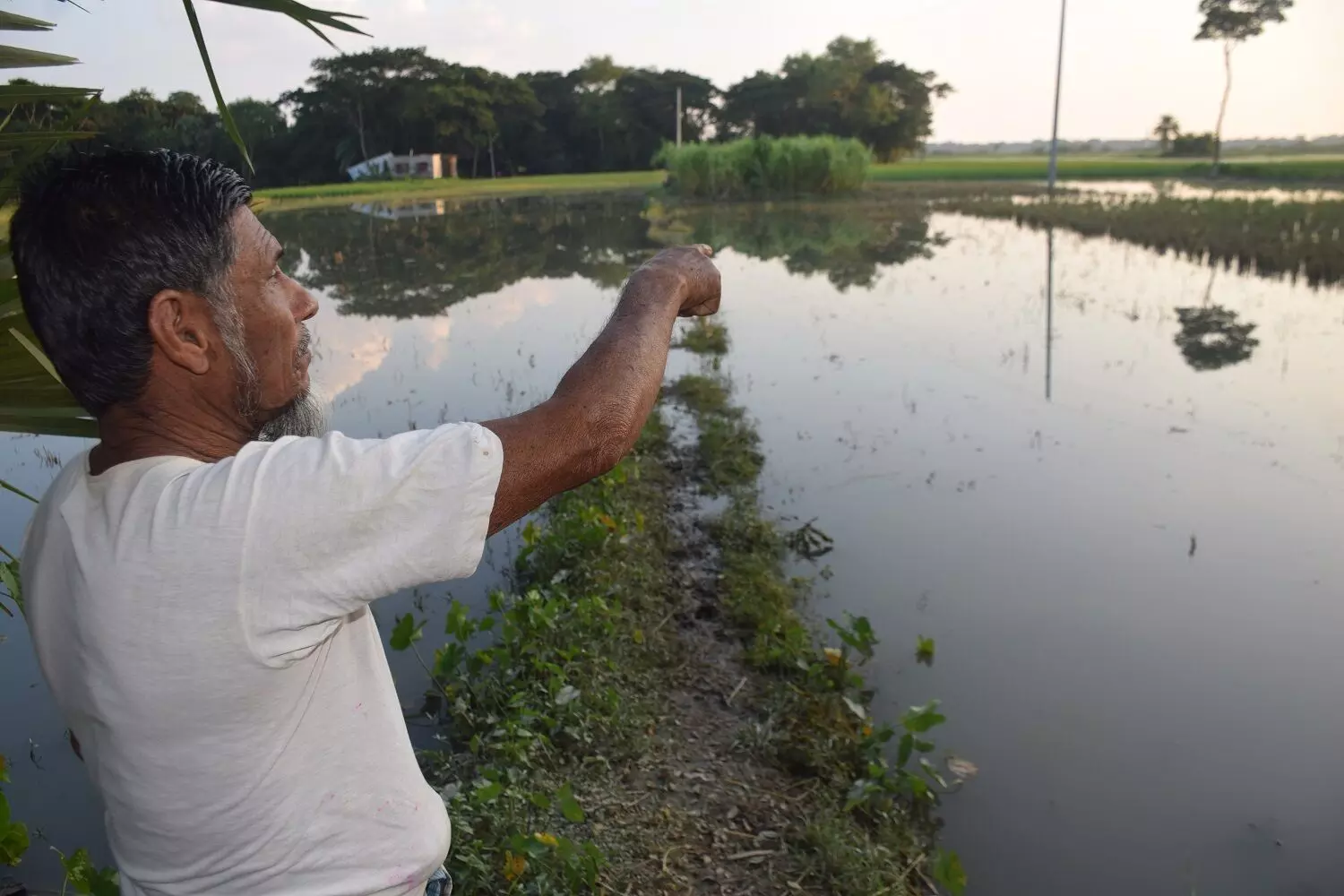
Abdul Quader, a resident of Majherchar, wanted to grow winter vegetables on his land. But his land is now under water.
After Cyclone Sitrang, the suffering of the people of Majherchar, an island in Badarkhali union of Barguna district, has gone beyond limits. Crop fields, roads, and houses are submerged under water.
Bachchu Dafadar, a resident of Majherchar island in Badarkhali union of Barguna district said the livelihood of the inhabitants depended most only on the Aman crop, winter crop and river fishing.
“Most of the areas of this island are now under water. Not just the Aman paddy, but some of us had begun planting our winter crops and they are damaged too. Sitrang swept everything away,” Dafadar told Gaon Connection. “We are always the worst hit and the first victims of natural disasters. There has to be a strong embankment built to protect the people of this island,” he said.
From Sidr to Sitrang
There have been 12 cyclones that have lashed Bangladesh between 2007 and 2022. In 2007, it was Super Cyclone Sidr. Just two years later in 2009, Cyclone Aila hit. This was followed by Cyclone Mahasen in 2013, Cyclone Komen in 2015, Cyclone Roanu in 2016, Cyclone Mora in 2017, Cyclone Titli in 2018, Cyclone Fani and Cyclone Bulbul in 2019, Super Cyclone Amphan in 2020, Cyclone Yaas in 2021, and Cyclone Sitrang in 2022.
The repeated onslaught of cyclones has led to unprecedented relocation and migration of the local inhabitants of coastal Bangladesh.
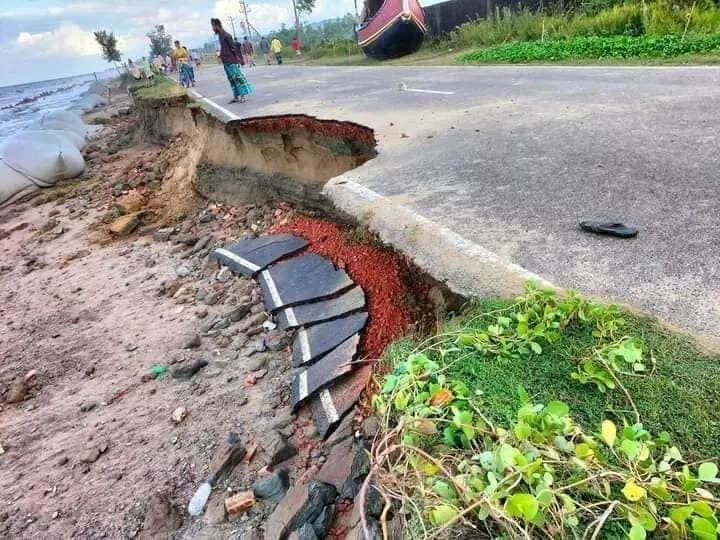
Marine drive road in Teknaf, Cox’s Bazar damaged by Cyclone Sitrang. Photo: By arrangement.
Also Read: In Deep Waters: Is climate change impacting the reproductive health of women in coastal Bangladesh?
“Embankments must be built along the entire coast. They should be strong and high enough to withstand the cyclones. Cyclone shelters should also be improved and managed better,” Ainun Nishat, professor emeritus at BRAC University, Dhaka, told Gaon Connection.
The climate expert added that even the construction of homes along the coast should be built like cyclone shelters.
According to Nishat, there was also the problem of people not comprehending the cyclone warning signals that are issued in the various ports. The warnings should be issued area wise where the names of the village or Upazila the cyclone is likely to hit are clearly indicated.
“The ministry of agriculture should also be involved with the process of cyclone warnings as they can guide the farming community of the steps they should take to safeguard their crops,” he pointed out.







